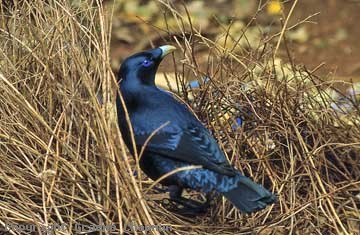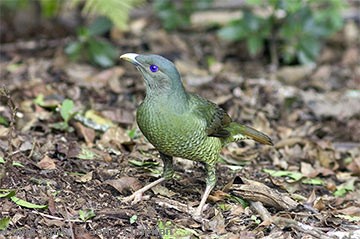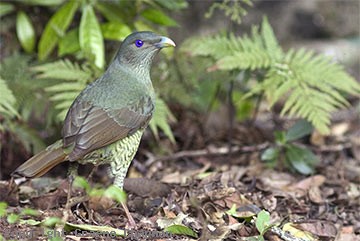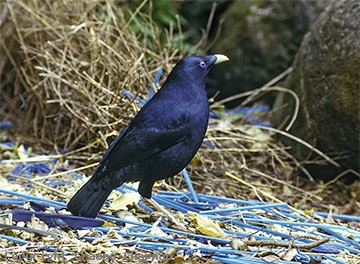
Satin Bowerbirds are probably the most well-known of all the bowerbirds in Australia, mainly because they range up and down the east coast close to more populated areas, but also because of their habit of collecting blue objects - clothes pegs are a favourite! There are two subspecies. The smaller, not so well-known northern one is found in the highlands of NE Queensland from the Atherton Tableland south to the Seaview Range west of Ingham. The southern subspecies occurs from Kroombit Tops (W of Rockhampton) throughout the coast and ranges south to Melbourne and across to the Otway Range in Victoria. When breeding they live in wet forest and woodlands and around the edges of rainforests but they have also adapted well to the spread of human habitation and in greener areas maintain territories in gardens and backyards.
In winter flocks of green immatures move into more open country and can become a nuisance in gardens and cultivated crops. In the wild they are fairly omnivorous and feed on a range of plant and animal material. As well as fruit, flowers, nectar and seeds they are particularly fond of fresh green growth and this is where they come into conflict with gardeners. Crops like green beans need to be netted where Satin Bowerbirds are around, otherwise you'll harvest nothing!
In suitable habitat bowers may average five per sq. km. and be spaced roughly 300 metres apart, so each male is well within earshot of his neighbours. In each territory, there is usually a number of green birds, either females (black bills) or subordinate males (pale bills) that may try to establish rudimentary bowers; these subordinate males don't acquire blue adult plumage until their fifth or sixth year. The main bower in a territory is maintained by a single blue male. That is where he courts and finally mates with his females (he mates with several) and it is the centrepiece of the territory. There is fierce competition at these bowers - neighbouring males will attempt to destroy the bower and pinch the sticks or ornaments, taking them to their own bowers and young males also come to try to display and steal things as well. Usually a new bower is constructed each year, close to the previous one - the site is traditional - it may be used by a succession of different owners. Decorations are mainly blue, violet, purple or greenish yellow. The blue tail feathers of Crimson Rosellas are a favourite in the wild, but near habitation all sorts of plastic objects are collected. At one stage near Sydney birds were removing the blue plastic rings off the top of milk bottles and getting their heads stuck in the ring, so the makers kindly changed the colour of the ring - end of problem.
Many people think that bowers are connected with nesting, but that isn't so. The female Satin Bowerbird builds a bowl-shaped nest usually in the thick crown of a tree or shrub, a mass of vines or clump of mistletoe on average about 15 metres above ground and she fiercely defends this against all except the meanest of predators. An average of two young ones are raised and she alone does all the domestic duties, brooding the eggs and feeding the young.









